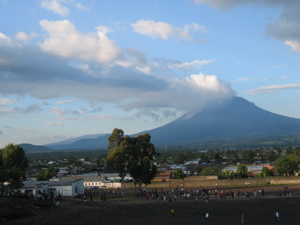Sponsors: National Science Foundation Petrology and Geochemistry program,
National Geographic Society

Sulfur dioxide (SO2) emissions from non-arc volcanoes constitute a significant component of the global
volcanic sulfur budget, and have been assumed to scale directly with erupted lava volume (i.e. that there is no
'excess sulfur'). However, to date there have been very few efforts to prove this, particularly for alkaline
volcanoes. This project will merge remote sensing and petrological analysis to investigate the origins and
dynamics of SO2 emissions from Nyamuragira and Nyiragongo, the active, alkaline volcanoes in the
Virunga region of the western arm of the East African Rift in DR Congo. Both Nyamuragira and Nyiragongo are
prodigious sulfur emitters, the former during its frequent effusive eruptions and the latter via persistent
passive degassing since 2002. To date there has been no concerted attempt to link these SO2 emissions
with magma production, or to investigate the origin of the exceptional SO2 output. The main components
of the VISOR project are: (1) Analysis of satellite data collected by several instruments since 1978 to develop
a complete record of recent SO2 emissions from the Virunga volcanoes. An up-to-date map of recent
lava flows will also be constructed; (2) Fieldwork in DR Congo to collaborate with Congolese scientists at the
Goma Volcano Observatory (GVO) on ground-based SO2 monitoring at Nyiragongo, including measurement of SO2
emissions and interpretation of the data alongside other volcanological datasets collected by GVO and collaborators.
Validation of satellite measurements will be achieved by comparing coincident field- and satellite-based
SO2 measurements; (3) Petrological analyses of volatile concentrations and speciations in historical
eruptive products of Nyamuragira and Nyiragongo to determine the extent of magma degassing during eruptions.
These data will be combined with the remotely sensed SO2 measurements to assess the relationship
between melt sulfur loss and measured SO2 production for a series of eruptive events; thus shedding
new light on the incidence of excess sulfur emissions at non-arc, alkaline volcanoes, and into the behavior of
sulfur and other volatiles in alkali-basaltic magmas. Broader impacts of this study include: strengthening of
international collaborative links between groups in the USA, Africa, and Europe; a valuable infusion of expertise
and collaborative activity for African scientists at GVO, which has suffered many years of neglect and civil
unrest; outreach projects in Goma using satellite data acquired for the project; and the addition of exotic
volcanic rock compositions to the National Rock Collection archive at the Smithsonian Institution, for future
research efforts.